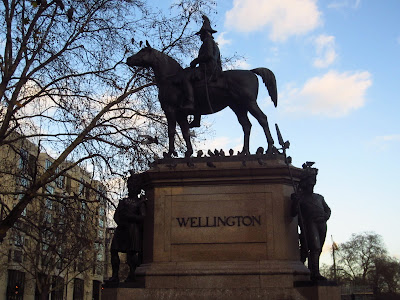The multi-storied British Library with St. Pancras Hotel in the background. The library building was dedicated in 1998.
Statue of Newton by Eduardo Paolozzi in the library's courtyard. This same statue, although a miniature version, is on display at Cambridge's Isaac Newton Institute.
special gallery. We saw illuminated sacred texts including the Lindisfarne Gospels, manuscripts from a number of English authors, original lyrics from the Beatles, and a whole room dedicated to the Magna Carta whose various clauses have been repealed and reconfirmed many times. Today only three clauses are still in effect, most notably the one dealing with due process. There was also a display of original writings, images, and modern interpretations about the imprisonment of Mary, Queen of Scots. It's not clear that supporters of Mary would have agreed with the interpretations...
After lunch in the library's beautiful restaurant, we took the underground and headed to Hyde Park, London's version of Central Park. The tube was packed--little did we know that Hyde Park was hosting a "Winter Wonderland" and families and tourists from all over were flocking to it. Our first glimpse of the park was a statue dedicated to the first Duke of Wellington, who along with Prussian forces, defeated Napoleon at Waterloo.
The pigeons love him too.
We know a triumphal arch when we see one! This one was dedicated to Wellington and is now managed by the National Trust organization. There is another arch at the other end of the park, Marble Arch, which is based on the design of Rome's Arch of Constantine.
 Apsley House, home of the Duke of Wellington. Its address is (was) #1 London |
 |
Statue of Achilles dedicated to Wellington |
Our last stop of the day was the British Museum, home of artifacts from all over the ancient world and beyond. Its most famous holding is the Rosetta Stone, key to deciphering Egyptian hieroglyphics. It had been found by the French in 1799 but handed over to the victorious British during the Napoleonic Wars. Since 2003 Egypt has been demanding its return.

Leaving the Egyptian exhibits behind (and tons of tourists crowding around the famous stone), we headed upstairs to visit displays on the ancient Romans. They are beginning to seem like old acquaintances since we've been encountering them ever since we've been here. This time we were able to attach some faces to famous names.
Hadrian, builder of walls;
Marcus Aurelius, philosopher emperor;
and finally,
Septimius Severus, conquerer of Mesopotamia, fighter in Scotland, and
perhaps.....
lover of too much pasta!








No comments:
Post a Comment